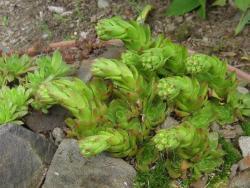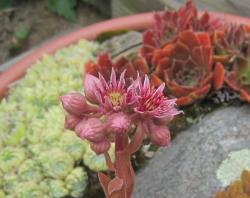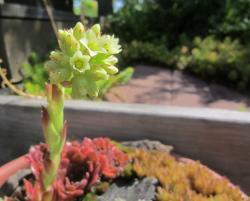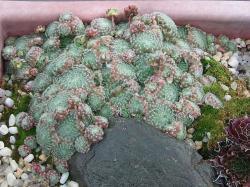I don't fertilize my semps, and I grow them in lean sandy soil. Some years they don't flower at all, while in other years they might bloom profusely. I'm not really interested in the flower per se, other than for hybridization. What encourages semps to flower, fertilizer, more abundant watering? Is it just age/maturity of rosettes?
S. heuffelii 'Gold Bug' in mid July 2013, nearly 50% of rosettes wereflowering. The next time it flowered was this past summer 2017, with 2 rosettes blooming. Most years no flowers.

In most years my mature clump of 'Nouveau Pastel' does not flower, if it does flower there might be just 1 - 2 rosettes that flower. One year (2014) there were lots of flower stems. I'm very interested hybridizing with this one, unfortunately that year I was still working crazy hours and I missed the opportunity. View of a single flower stem with heuffelii 'Torrid Zone' and ciliosum ssp. ciliosum (sy. var. borisii) in the background.

S. heuffelii 'Torrid Zone', a Bill Nixon hot one, in 2017 had one rosette that flowered. I hand pollinated nearly every flower on this stem (flowers were emasculated) with pollen from 'Gold Bug'. Mid July 2017, with bright red rosettes in view, and the tawny tan rosettes of 'Nouveau Pastel' in the background.

S. ciliosum ssp. cilosum (got it many years ago under current synonym of var. borisii), it almost never flowers. This photo of a rare flowering moment in June 2001, nearly 17 years ago. I wish this one would flower more, as the flowers are very attractive, bright yellow, stems not too tall, and I would use it for hybridization. This particular planter had aged and was breaking up, so I moved it to a new dish-style planter, where it always looks great but has never flowered since. Three views: in flower June 2001. Same plant mid November 2001 when frozen. Plant in dish-style planter in May 2010 taking on a red flush of color.



Final image, close-up of S. ciliosum ssp. cilosum (syn. var borisii) in mid June 2016, catching glimpse of red heuffelii 'Torrid Zone' and dark tan 'Nouveau Pastel' above.







